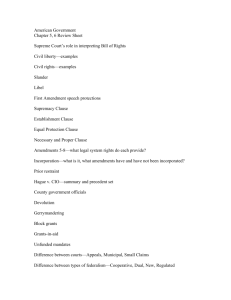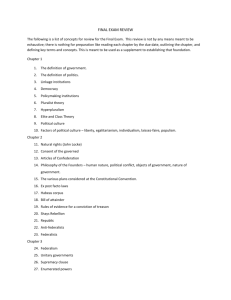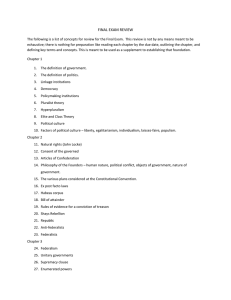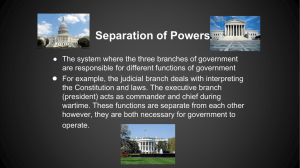Chapter 3: Federalism I Roots of the Federal System and the
advertisement
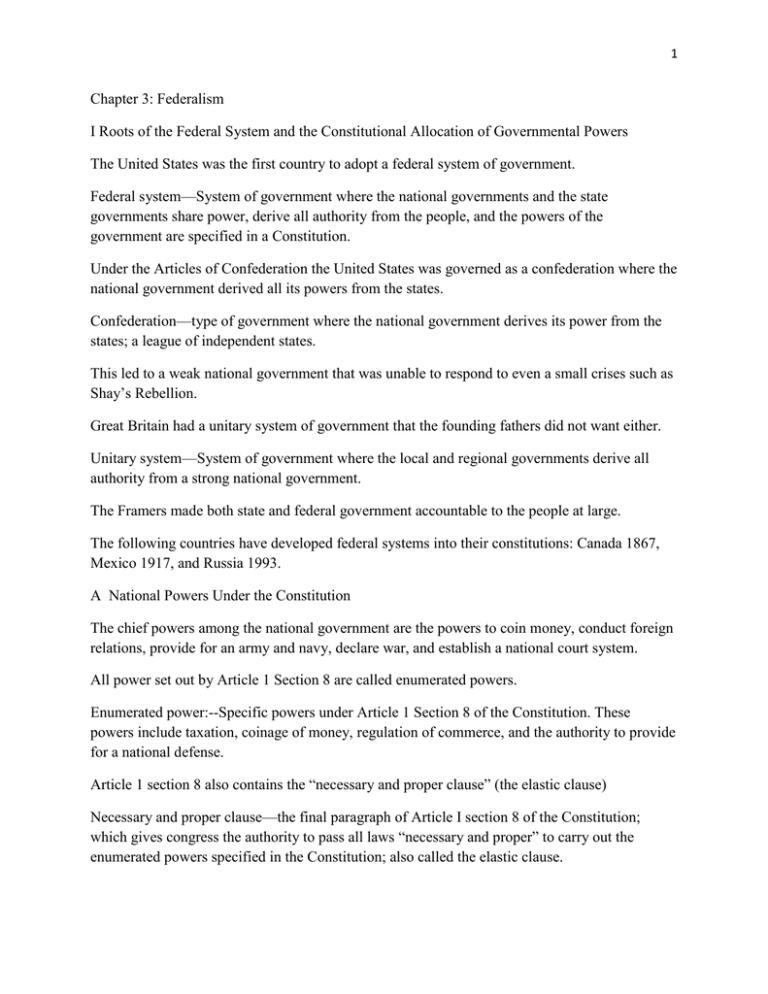
1 Chapter 3: Federalism I Roots of the Federal System and the Constitutional Allocation of Governmental Powers The United States was the first country to adopt a federal system of government. Federal system—System of government where the national governments and the state governments share power, derive all authority from the people, and the powers of the government are specified in a Constitution. Under the Articles of Confederation the United States was governed as a confederation where the national government derived all its powers from the states. Confederation—type of government where the national government derives its power from the states; a league of independent states. This led to a weak national government that was unable to respond to even a small crises such as Shay’s Rebellion. Great Britain had a unitary system of government that the founding fathers did not want either. Unitary system—System of government where the local and regional governments derive all authority from a strong national government. The Framers made both state and federal government accountable to the people at large. The following countries have developed federal systems into their constitutions: Canada 1867, Mexico 1917, and Russia 1993. A National Powers Under the Constitution The chief powers among the national government are the powers to coin money, conduct foreign relations, provide for an army and navy, declare war, and establish a national court system. All power set out by Article 1 Section 8 are called enumerated powers. Enumerated power:--Specific powers under Article 1 Section 8 of the Constitution. These powers include taxation, coinage of money, regulation of commerce, and the authority to provide for a national defense. Article 1 section 8 also contains the “necessary and proper clause” (the elastic clause) Necessary and proper clause—the final paragraph of Article I section 8 of the Constitution; which gives congress the authority to pass all laws “necessary and proper” to carry out the enumerated powers specified in the Constitution; also called the elastic clause. 2 Implied powers—powers derived from the enumerated powers and the necessary and proper clause. These powers are not stated specifically but are considered to be reasonably implied through the exercise of delegated powers. The federal government clearly had to have the right to tax to raise funds for the national government. This was clearly set out in the 16 Amendment 1913; this would become a further catalyst for further expansion of the national government. Article VI—the national government is to be supreme in situations of conflict between state and national law. It declares that the U.S. Constitution, the laws of the United States, and its treaties, are to be the “the supreme law of the land; and the Judges in every State shall be bound thereby.” Supremacy Clause—Portion of Article VI of the Constitution mandating that national law is supreme to (that is supersedes) all other laws passed by the states or by any other subdivision. Ex. 1920 case against the Migratory Bird Act of 1918 b/w Missouri and Canada. B State Powers Under the Constitution Article 1: states are allowed to set the times, places, and manner for holding elections for senators and representatives. Article 2: each state must appoint electors to vote for the president Article 4: provides each states a republican form of government; meaning one that represents the citizens of the state. Tenth Amendment—the final part of the Bill of Rights that defines the basic principle of American Federalism in stating “the powers not delegated to the United States by the Constitution, nor prohibited by it to the States, are reserved to the States respectively, or to the people. These are called the reserve powers Reserved (or police) powers—Powers reserved to the states by the 10th Amendment that lie at the foundation of a state’s right to legislate for the public health and welfare of its citizens. Reserve powers include the ability to legislate for public health safety, and morals of their citizens. Many states use this to place restrictions on abortions or to fund stem-cell research. Police powers are also the basis for state criminal laws including varied laws concerning the death penalty. 3 C Concurrent Powers Under the Constitution Concurrent powers—authority possessed by both the state and national governments that may be exercised concurrently as long as that power is not exclusively within the scope of national power or in conflict with national law. Important concurrent powers: the power to tax, right to borrow money, establish courts, and make and enforce laws necessary to carry out these powers. D Powers Denied Under the Constitution States are denied the power to enter into treaties, coin money, impairing obligation of contracts, states cannot enter into compacts with other states without express congressional approval. Congress cannot favor one state over another in regulating commerce, nor can it lay duties on items exported from any state. State and national governments are denied that authority to make arbitrary actions affecting constitutional rights and liberties. Neither national or state governments can pass a Bill of attainder: a law declaring an act illegal without a judicial trial. National and state governments cannot pass ex post facto laws—law that makes an act punishable as a crime even if the action was legal at the time it was committed. E Relations Among the States Article III any dispute b/w states should be handled by the Supreme Court under its jurisdiction. Article IV provide the full faith and credit clause Full faith and credit clause—Section of Article IV of the Constitution that ensures judicial decrees and contracts made in one state will be binding and enforceable in any other state. Ex a state’s refusal to honor a same sex marriage contract. Privileges and immunities clause—Part of Article IV of the Constitution guaranteeing that the citizens of each state are afforded the same rights as citizens of all other states. Extradition clause—Article IV of the constitution that requires states to extradite or return, criminals to states where they have been convicted or are to stand trial. Interstate compacts—contracts b/w states that carry the force of law; generally now used as a tool to address multistate policy concerns. Over 200 interstate compacts exist today. 4 States today find that interstate compacts help them to maintain control because compacts with other states allow for sharing resources, expertise, and responses that often are available more quickly than those from the federal government. Ex. Emergency Management Assistance Compact F Relations within the States: Local Government The constitution gives local governments, including counties, municipalities, townships, and school districts, no independent standing. Their authority is not granted directly by the people but through state governments, which establish or charter administrative subdivisions to execute the duties of the state government on a smaller scale. II Federalism and the Marshall Court Much of the change in the nature of federalism has been due to the rulings of the Supreme Court. The supreme court had played a major role in defining the nature of the federal system b/c the distribution of power b/w the national and state governments is not clearly delineated in the Constitution. The court with the greatest impact was the Marshall Court led by Chief Justice John Marshall (1801-1835) The two rulings of the most importance was McCulloch v. Maryland (1819) and Gibbons v. Ogden (1824) A McCulloch v. Maryland (necessary and proper clause) McCulloch v. Maryland (1819)—the Supreme Court upheld the power of the national government and denied the right of a state to tax the federal bank using the Constitution’s supremacy clause. The Court’s broad interpretation of the necessary and proper clause paved the way for the later rulings upholding expansive federal powers. This was the first major Supreme Court decision to define the relationship b/w the national and state governments. In 1816, Congress chartered the Second Bank of the United States. In 1818, the Maryland state legislature levied a tax requiring all banks not chartered by Maryland (that is the Second Bank of the United States) to (1) buy stamped paper from the state on which the Second Bank’s notes were to be issued; (2) pay the state $15,000 a year or (3) go out of business. James McCulloch, the head teller of the Baltimore Branch of the Bank of the United States, refused to pay the tax, and Maryland brought suit against him. After losing in the Maryland state 5 court, McCulloch appealed the decision to the U.S. supreme court by order of the U.S. Secretary of the Treasury. In an unanimous decision the Court answered the two central questions that had been presented to it: 1. Did Congress have the authority to charter a bank? 2. If it did, could a state tax it? Chief Justice John Marshall’s answer to the first question stands as the classic example of the doctrine of implied powers and as a reaffirmation of the authority of a strong national government. Although the word “bank” cannot be found in the Constitution, the Constitution enumerates powers that give Congress the authority to levy and collect taxes, issue currency, and borrow funds. From these enumerated powers Marshall found it was reasonable to imply that Congress had the power to charter a bank which could be considered “necessary and proper” to the exercise of its aforementioned enumerated powers. Marshall then addressed the second question; whether a federal bank could be taxed by a state government. To Marshall the national government was dependent on the people, not the states, for its powers and the Constitution specifically calls for the national government to be Supreme. “The Power to tax involves the power to destroy.” Wrote Marshall. Thus the state tax violated the supremacy clause, because individual states cannot interfere with the operations of the national government, whose laws are supreme. The Necessary and Proper Clause is used to justify federal action in many areas. B Gibbons v. Ogden (1824) (Commerce Clause) Gibbons v. Ogden (1824)—The Supreme Court upheld broad congressional power to regulate interstate commerce. The Courts broad interpretation of the Constitution’s commerce clause paved the way for later rulings upholding expansive federal powers. This was a dispute that arose after the New York state legislature granted Robert Fulton the exclusive right to operate steamboats on the Hudson River. At the same time, Congress licensed a ship to sail on the same waters. The Case developed to where both New York and New Jersey wanted to control shipping on the lower Hudson River. The main question in Gibbons: What was the scope of Congress’s authority under the Commerce Clause? The Supreme Court ruled that Congress’s power to regulate interstate commerce included the power to regulate commercial activity as well and that the commerce power had no limits except those specifically found in the Constitution. 6 New York had no constitutional authority to grant a monopoly to a single steamboat operator, an act that interfered with interstate commerce. This has been used to justify legislation concerning regulation of highways, the stock market, and violence against women. III Dual Federalism: The Taney Court, Slavery, and the Civil War Under Supreme Court Chief Justice Roger B. Taney (1835-1863) that the Supreme Court articulated the notions of concurrent power and dual federalism. Dual Federalism—the belief that having separate and equally powerful levels of government is the best arrangement. A Dred Scott and the Advent of the Civil War During this era the justices were called upon to deal with the controversial issue of slavery. In cases like the Dred case the Court tried to manage the slavery issue by resolving questions of ownership, the status of fugitive slaves, and slavery in the new territories. They generally were solved in favor of state’s rights within the framework of dual federalism. In Dred Scott case the Taney Court declared the Missouri Compromise unconstitutional and ruled that Congress lacked the authority to ban slavery in the territories. This decision seemed to rule out any nationally legislated solution to the slavery question, leaving the problem in the hands of the state legislatures and the people, who did not have the power to impose their will on other states. B The Civil War, Its Aftermath, and the Continuation of Dual Federalism Civil War (1861-1865) forever changed the nature of federalism After the war the national government grew in size and power. The national government also attempted to impose its will on state governments by the 13th, 14th, and 15th amendments aka the Civil War Amendments. These amendments prohibited slavery and granted civil and political rights including voting rights to African-Americans. Despite the national governments new powers the importance of state governments was not diminished until 1933. 7 After Plessy v. Ferguson (1896) in which the court ruled the maintenance of “separate but equal” facilities for blacks and whites was constitutional, most civil rights and voting cases also became matters of the state in spite of the Civil War Amendments. Passage of laws such as the Interstate commerce Act in 1887 and the Sherman Anti-Trust Act in 1890 allowed Congress to establish itself as an important player in the growing national economy. C Setting the Stage for a Stronger National Government 16th Amendment—Authorized Congress to enact a national income tax. The revenues taken in by the federal government through taxation of personal income “removed a major constraint on the federal government by giving access to almost unlimited revenues.” If money is power, the income tax and the revenues it generated greatly enhanced the power of the federal government and its ability to enter policy areas where it formerly had few funds to spend. 17th Amendment (1913)—Made senators directly elected by the people; removed their selection from state legislatures.(also enhanced the national power at the expense of the states) With senators on longer directly accountable to the state legislators that elected them, states’ lost their principle protectors in Congress. The 16th and 17th amendment paved the way for more drastic changes in the relationship b/w national and state governments. Discuss the development of national power from 1835-1933 be sure to include dual federalism, 16th and 17th amendments dred and plessy cases. IV Cooperative Federalism: The New Deal and the Growth of the National Government Dual federalism came to an end in the 1930’s with a series of economic events. 1. 2. 3. 4. 5. 1920’s bank failures were common. 1921 the nation experienced a severe slump in agricultural prices 1926, the construction industry went into decline 1929 inventories of consumer goods and automobiles were at an all-time high. October 1929 stock prices which had risen steadily since 1926 crashed taking with them the entire national economy. A The New Deal 8 Most politicians during the New Deal period (1933-1939) under president FDR agreed that to find solutions to the Great Depression the national government would have to exercise tremendous authority. New Deal programs forced all levels of government to work cooperatively with one another. The Supreme court continued to keep a laissez-faire attitude toward governments interference in the economy ruling many of FDR’s New Deal plans unconstitutional. B The Changing Nature of Federalism: From Layer Cake to Marble Cake Before the Depression and New Deal Federalism was like a layer cake with each level or layer of government—national, state, and local—had clearly defined powers and responsibilities. After the New Deal government looked more like a marble cake Marble cake federalism refers to cooperative federalism Cooperative federalism—the intertwined relationship between the national, state and local governments that began with the New Deal. States began to take a secondary, important cooperative role in the scheme of governance The shift in power is most apparent in the growth of the national government in the area of federal grant programs that began during the new deal. Between the New Deal and the 1990’s the tremendous growth in these programs and in federal government spending changed the nature and discussion of government spending from “how much power should the national government have?” to “How much say in the policies of the states can the national government buy?” Ex. National speeding limit of 55 in the 1970’s and drinking restrictions. C Federal Grants and National Efforts to Influence the States Start of the Redistribution of Funds began with the Morrill Land Grant Act of 1862 which 30,000 acres of public land for each representative in Congress. Profits from the sale of these lands was to go to the develop of agricultural and mechanical colleges. This was the single most important piece of education legislation passed in the United States up to that time. By the 1950’s and 60’s federal grant and aid programs were well entrenched—often they clearly defined federal/state relationships and mad the national government a major player in domestic policy. Until the 1960’s most federal grants were categorical grants 9 Categorical grants—grants that allocated federal funds to states for a specific purpose. Categorical grants allocate federal dollars by a precise formula and are subject to detailed conditions imposed by the national government, often on a matching basis; that is, states must contribute money to match federal funds, although the national government may pay as much as 90% of the total. Early 1960’s concern about poor and minorities rose/ states were blamed/ Those in power saw it as a way to force states to conform or the national government would withhold funds. 1964 LBJ and the Great Society Program during this program the national government began to use federal grants as a way to further what federal (and not state) official perceived to be national needs. 1970’s presidents voiced their opposition to big government their efforts to rein it in were largely unsuccessful. V New Federalism: Returning Power to the States 1980 Ronald Reagan was elected and pledged to advance what he called New Federalism New Federalism—Federal-state relationship proposed by Reagan administration during the 1980’s; hallmark is returning state powers to the state governments. Policy was maintained from 1980’s to 2001. 9/11/2001 terrorist attacks led to substantial growth in the power and scope of the federal government. A The Reagan Revolution President Reagan dramatically cut federal spending to state and local governments. He did this in part to curtail federal spending. He made massive cuts in federal domestic programs and drastic income tax cuts. He persuaded Congress to consolidate many categorical grants into far fewer less restrictive block grants Block grants—broad grant with few strings attached; given to states by the federal government for general categories of activity, such as secondary education or health services. He also ended general revenue sharing. By the end of the Reagan and Bush era in 1993 most block grants fell into one of four categories: health, income, security, education, or transportation. New Federalism had taken hold. 10 B The Devolution Revolution 1992 President Bill Clinton was elected ( the first democrat in 12 years) Devolution Revolution—Republican Candidates pledged to force a national debate on the role of the national government in regard to the states. Their top priority was scaling back the federal government. Unfunded Mandates—national laws that direct state or local governments to comply with federal rules or regulations (such as clean air or water standards but contain little or no federal funding to defray the cost of meeting these requirements. Another important act passed by the Republican-controlled Congress and signed into law by Pres. Clinton was the Personal Responsibility and Work Opportunity Reconciliation Act of 1996. This act replaced the existing welfare program known as Aid to Families with Dependent Children (AFDC) with a program known as Temporary Assistance to Needy Families (TANF). TANF returned much of the Administrative power for welfare programs to the states and became a hallmark of the devolution revolution. In the short term, these and other federal programs coupled with a growing economy produced record federal and state budget surpluses. States were in the best shape they had been in since the 1970’s. C Federalism Under the Bush Administration Under Bush’s presidency (who ran to further reduce government involvement), the US experienced terrorist attacks, the invasion of Afghanistan, the war in Iraq, as well as the rising costs of education and welfare, produced state and federal budget deficits that would have been unimaginable only a few years before. No Child Left Behind Act was viewed by many as an unprecedented usurpation of state and local powers. It followed a trend of preemption—a concept derived from the Constitution’s supremacy clause that allows the national government to override or preempt state or local actions in certain areas. This began in 1965 during the Lyndon B Johnson era. Congress uses its authority under the commerce clause to preempt state laws. Usually supported by Democrats use by the Bush administration shows a shift in politics. VI Toward Reform: A New Judicial Federalism Cannot underestimate the role of the Supreme Court in determining the parameters of federalism Neither can the role of the Executive Branch in advocating certain positions before the Court. 11 1930’s New Deal legislation it was not until the Supreme Court reversed itself and found the programs constitutional that any real change occurred in the federal state relationship. From the New Deal to the 1980’s, the Supreme Court’s impact on the federal system generally was to expand the national government’s authority at the expense of the states. Sovereign immunity—the right of a state to be free from a lawsuit unless it gives permission to the suit. Under the 11th Amendment, all states are considered sovereign. Key Terms: Bill of attainder, block grant, categorical grant, concurrent powers, confederation, cooperative federalism, dual federalism, enumerated powers, ex post facto law, extradition clause, federal system, full faith and credit clause, Gibbons v. Ogden implied powers, interstate compacts, McCulloch v. Maryland, necessary and proper clause, New Federalism, preemption, privileges and immunities clause, reserve (or police) powers, 17th Amendment, 16th Amendment, sovereign immunity, supremacy clause, 10th Amendment, Unfunded mandates, unitary system.

